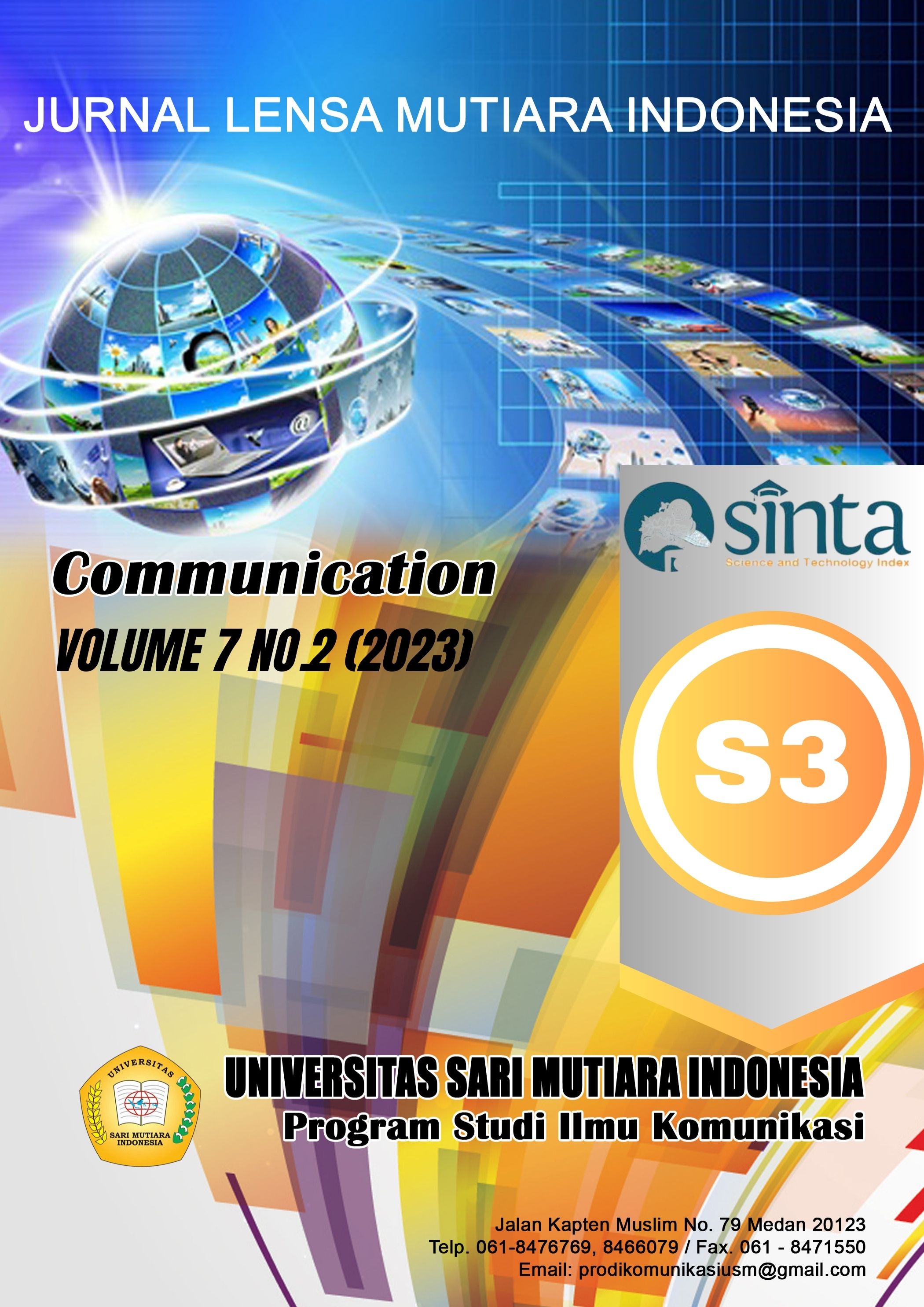Phubbing, Komunikasi Interpersonal, dan Etika Komunikasi dalam Masyarakat
Main Article Content
Abstract
Currently, technology is rapidly increasing advancing and developing. Communication technology, especially smartphones, has experienced rapid development with up-to-date technologies and features attached. Amidst the rapid development of technology and features attached to communication tools, the phubbing phenomenon has emerged which occurs at almost all levels of society. The emergence of this phenomenon become one of the developments of communication technology especially cell phones negative impacts, which results in the disruption of relationships between individuals due to too much focus on cell phones. This phenomenon has a bad impact on technological developments and hurts phubbers mental health. literature reviews or desk research. The aim is to provide a comprehensive knowledge of the phubbing phenomena, which is happening unintentionally in society, by drawing on prior research. This article’s purpose is to provide a comprehensive understanding of phubbing and its effects on communication and mental health in society. The goal is to raise awareness and propose preventive measures to mitigate any additional adverse consequences. The findings of this paper demonstrate that the phubbing phenomenon is a negative consequence resulting from the quick and substantial advancements in technology. In Indonesian society, the phenomenon of phubbing is not widely recognized. From the standpoint of communication ethics, this phenomenon is clearly the opposite of face-to-face communication norms and ethics, as it involves disregarding the individual with whom one is conversing. Ultimately, comprehensive community involvement and extensive study are essential to gain a deeper understanding and develop proactive strategies to address the rise of the phubbing phenomena.
Downloads
Article Details

This work is licensed under a Creative Commons Attribution-NonCommercial-ShareAlike 4.0 International License.
References
Abeele, Mariek Vanden. 2020. “The Social Consequences of Phubbing: A Framework and a Research Agenda.” In The Oxford Handbook of Mobile Communication and Society, 157–74. Oxford: Oxford University Press. https://doi.org/10.1093/OXFORDHB/9780190864385.013.11.
Ball-Rokeach, S. J., and M. L. Defleur. 1976. “A Dependency Model of Mass-Media Effects.” Communication Research 3 (1): 3–21. https://doi.org/10.1177/009365027600300101.
Barford, Vanessa. 2013. “Is Modern Life Making Us Lonely?” BBC News Magazine. April 8, 2013. https://www.bbc.com/news/magazine-22012957.
Chotpitayasunondh, Varoth, and Karen M. Douglas. 2018. “The Effects of ‘Phubbing’ on Social Interaction.” Journal of Applied Social Psychology 48 (6): 304–16. https://doi.org/10.1111/JASP.12506.
Creswell, John W., and J. David Creswell. 2022. Research Design: Qualitative, Quantitative, and Mixed Methods Approaches. Sixth. Los Angeles: SAGE Publications.
Crowe, Sarah, Kathrin Cresswell, Ann Robertson, Guro Huby, Anthony Avery, and Aziz Sheikh. 2011. “The Case Study Approach.” BMC Medical Research Methodology 11: 100. https://doi.org/10.1186/1471-2288-11-100.
Garrido, Estefanía Capilla, Tomayess Issa, Prudencia Gutiérrez Esteban, and Sixto Cubo Delgado. 2021. “A Descriptive Literature Review of Phubbing Behaviors.” Heliyon 7 (5): e07037. https://doi.org/10.1016/J.HELIYON.2021.E07037.
Habuchi, I. 2005. “Accelerating Flexibility.” In Personal, Portable, Pedestrian : Mobile Phones in Japanese Life, edited by MizukoOkabe, Daisuke Itō and Misa Matsuda, 165–82. MIT Press. https://doi.org/https://doi.org/10.7551/mitpress/5309.001.0001.
Johnston, Melissa P. 2014. “Secondary Data Analysis_ A Method of Which the Time Has Come.” Qualitative and Quantitative Methods in Libraries (QQML) 3: 619–26.
Kelly, Heather. 2015. “Resolve to Put down Your Smartphone .” CNN Business. January 1, 2015. https://edition.cnn.com/2015/01/01/tech/mobile/smartphone-new-years-resolution/.
Lariccia, Frederica. 2023. “Smartphones - Statistics & Facts .” Statista. June 6, 2023. https://www.statista.com/topics/840/smartphones/#topicOverview.
Littlejohn, Stephen W., Karen A. Foss, and John G. Oetzel. 2017. Theories of Human Communication. Eleventh. Long Grove, Illinois : Waveland Press, Inc.
Misra, Shalini, Lulu Cheng, Jamie Genevie, and Miao Yuan. 2016. “The IPhone Effect: The Quality of In-Person Social Interactions in the Presence of Mobile Devices.” Environment and Behavior 48 (2): 275–98. https://doi.org/10.1177/0013916514539755.
Mohanty, Anita, Subrat Kumar Mohanty, Bhagyalaxmi Jena, Ambarish G. Mohapatra, Ahmed N. Rashid, Ashish Khanna, and Deepak Gupta. 2022. “Identification and Evaluation of the Effective Criteria for Detection of Congestion in a Smart City.” IET Communications 16 (5): 560–70. https://doi.org/10.1049/CMU2.12344.
Mount, Harry. 2015. “Was Albert Einstein Right about a Generation of Idiots? .” The Daily Mail. January 28, 2015. https://www.dailymail.co.uk/news/article-2929268/Was-Einstein-right-Physicist-said-feared-technology-surpass-human-interaction-photos-time-not-far-off.html.
Przybylski, Andrew K., and Netta Weinstein. 2013. “Can You Connect with Me Now? How the Presence of Mobile Communication Technology Influences Face-to-Face Conversation Quality.” Journal of Social and Personal Relationships 30 (3): 237–46. https://doi.org/10.1177/0265407512453827.
Roberts, James A., and Meredith E. David. 2016. “My Life Has Become a Major Distraction from My Cell Phone: Partner Phubbing and Relationship Satisfaction among Romantic Partners.” Computers in Human Behavior 54 (January): 134–41. https://doi.org/10.1016/J.CHB.2015.07.058.
Rubin, Alan M., and Sven Windahl. 1986. “The Uses and Dependency Model of Mass Communication.” Critical Studies in Media Communication 3 (2): 184–99. https://doi.org/10.1080/15295039609366643.
Saggaf, Yeslam al, and Sarah B. o’ Donnell. 2019. “Phubbing: Perceptions, Reasons behind, Predictors, and Impacts.” Human Behavior and Emerging Technologies 1 (2): 132–40. https://doi.org/10.1002/hbe2.137.
Snyder, Hannah. 2019. “Literature Review as a Research Methodology: An Overview and Guidelines.” Journal of Business Research 104 (November): 333–39. https://doi.org/10.1016/J.JBUSRES.2019.07.039.
Sun, Juhyung, and Jennifer A. Samp. 2022. “‘Phubbing Is Happening to You’: Examining Predictors and Effects of Phubbing Behaviour in Friendships.” Behaviour and Information Technology 41 (12): 2691–2704. https://doi.org/10.1080/0144929X.2021.1943711.
Swedberg, Richard. 2020. “Exploratory Research.” In The Production of Knowledge: Enhancing Progress in Social Science, edited by Colin Elman, James Mahoney, and John Gerring, 17–41. Strategies for Social Inquiry. Cambridge: Cambridge University Press. https://doi.org/DOI: 10.1017/9781108762519.002.
Woolley, Marcus. 1991. “Using Statistics for Desk Research.” In The Fourth Dawson’s Research Seminar, 227–33. Loughborough: Loughborough University of Technology.
